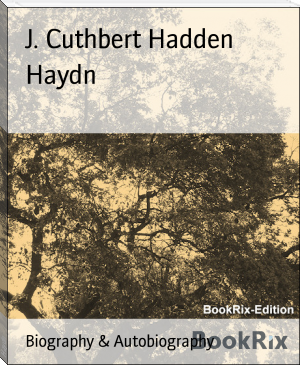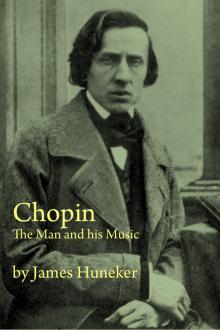Haydn by J. Cuthbert Hadden (books you need to read TXT) 📖

- Author: J. Cuthbert Hadden
Book online «Haydn by J. Cuthbert Hadden (books you need to read TXT) 📖». Author J. Cuthbert Hadden
This is a sufficient answer to the absurd statement which has been made, and is still sometimes repeated, that Bach was jealous of the young composer and abused him to his friends. A writer in the European Magazine for October 1784, says that Bach was "amongst the number of professors who wrote against our rising author." He mentions others as doing the same thing, and then continues: "The only notice Haydn took of their scurrility and abuse was to publish lessons written in imitation of the several styles of his enemies, in which their peculiarities were so closely copied and their extraneous passages (particularly those of Bach of Hamburg) so inimitably burlesqued, that they all felt the poignancy of his musical wit, confessed its truth, and were silent." Further on we read that the sonatas of Ops. 13 and 14 were "expressly composed in order to ridicule Bach of Hamburg." All this is manifestly a pure invention. Many of the peculiarities of Emanuel Bach's style are certainly to be found in Haydn's works--notes wide apart, pause bars, surprise modulations, etc., etc.--but if every young composer who adopts the tricks of his model is to be charged with caricature, few can hope to escape. The truth is, of course, that every man's style, whether in music or in writing, is a "mingled yarn" of many strands, and it serves no good purpose to unravel it, even if we could.
Violin Studies
Haydn's chief instrument was the clavier, but in addition to that he diligently practiced the violin. It was at this date that he took lessons on the latter instrument from "a celebrated virtuoso." The name is not mentioned, but the general opinion is that Dittersdorf was the instructor. This eminent musician obtained a situation as violinist in the Court Orchestra at Vienna in 1760; and, curiously enough, after many years of professional activity, succeeded Haydn's brother, Michael, as Capellmeister to the Bishop of Groswardein in Hungary. He wrote an incredible amount of music, and his opera, "Doctor and Apotheker," by which he eclipsed Mozart at one time, has survived up to the present. Whether or not he gave Haydn lessons on the violin, it is certain that the pair became intimate friends, and had many happy days and some practical jokes together. One story connected with their names sounds apocryphal, but there is no harm in quoting it. Haydn and Dittersdorf were strolling down a back street when they heard a fiddler scraping away in a little beer cellar. Haydn, entering, inquired, "Whose minuet is that you are playing?" "Haydn's," answered the fiddler. "It's a--bad minuet," replied Haydn, whereupon the enraged player turned upon him and would have broken his head with the fiddle had not Dittersdorf dragged him away.
Attempts at Programme Music
It seems to have been about this time--the date, in fact, was 1751--that Haydn, still pursuing his serenading practices, directed a performance of a quintet of his own composition under the windows of Felix Kurz, a well-known Viennese comedian and theatrical manager. According to an old writer, Kurz amused the public by his puns, and drew crowds to his theatre by his originality and by good opera-buffas. He had, moreover, a handsome wife, and "this was an additional reason for our nocturnal adventurers to go and perform their serenades under the harlequin's windows." The comedian was naturally flattered by Haydn's attention. He heard the music, and, liking it, called the composer into the house to show his skill on the clavier. Kurz appears to have been an admirer of what we would call "programme" music. At all events he demanded that Haydn should give him a musical representation of a storm at sea. Unfortunately, Haydn had never set eyes on the "mighty monster," and was hard put to it to describe what he knew nothing about. He made several attempts to satisfy Kurz, but without success. At last, out of all patience, he extended his hands to the two ends of the harpsichord, and, bringing them rapidly together, exclaimed, as he rose from the instrument, "The devil take the tempest." "That's it! That's it!" cried the harlequin, springing upon his neck and almost suffocating him. Haydn used to say that when he crossed the Straits of Dover in bad weather, many years afterwards, he often smiled to himself as he thought of the juvenile trick which so delighted the Viennese comedian.
His First Opera
But the comedian wanted more from Haydn than a tempest on the keyboard. He had written the libretto of an opera, "Der Neue Krumme Teufel," and desired that Haydn should set it to music. The chance was too good to be thrown away, and Haydn proceeded to execute the commission with alacrity, not a little stimulated, doubtless, by the promise of 24 ducats for the work. There is a playfulness and buoyancy about much of Haydn's music which seems to suggest that he might have succeeded admirably in comic opera, and it is really to be regretted that while the words of "Der Neue Krumme Teufel" have been preserved, the music has been lost. It would have been interesting to see what the young composer had made of a subject which--from Le Sage's "Le Diable Boiteux" onwards--has engaged the attention of so many playwrights and musicians. The opera was produced at the Stadt Theatre in the spring of 1752, and was frequently repeated not only in Vienna, but in Berlin, Prague, Saxony and the Breisgau.
An Aristocratic Appointment
An event of this kind must have done something for Haydn's reputation, which was now rapidly extending. Porpora seems also to have been of no small service to him in the way of introducing him to aristocratic acquaintances. At any rate, in 1755, a wealthy musical amateur, the Baron von Furnberg, who frequently gave concerts at his country house at Weinzierl, near Vienna, invited him to take the direction of these performances and compose for their programmes. It was for this nobleman that he wrote his first string quartet, the one in B flat beginning--
[figure: a musical score excerpt]
This composition was rapidly followed by seventeen other works of the same class, all written between 1755 and 1756.
Taken for an Impostor
Haydn's connection with Furnberg and the success of his compositions for that nobleman at once gave him a distinction among the musicians and dilettanti of Vienna. He now felt justified in increasing his fees, and charged from 2 to 5 florins for a month's lessons. Remembering the legend of his unboylike fastidiousness, and the undoubted nattiness of his later years, it is curious to come upon an incident of directly opposite tendency. A certain Countess von Thun, whose name is associated with Beethoven, Mozart and Gluck, met with one of his clavier sonatas in manuscript, and expressed a desire to see him. When Haydn presented himself, the countess was so struck by his shabby appearance and uncouth manners that it occurred to her he must be an impostor! But Haydn soon removed her doubts by the pathetic and realistic account which he gave of his lowly origin and his struggles with poverty, and the countess ended by becoming his pupil and one of his warmest friends.
A Count's Capellmeister
Haydn is said to have held for a time the post of organist to the Count Haugwitz; but his first authenticated fixed engagement dates from 1759, when, through the influence of Baron Furnberg, he was appointed Capellmeister to the Bohemian Count Morzin. This nobleman, whose country house was at Lukavec, near Pilsen, was a great lover of music, and maintained a small, well-chosen orchestra of some sixteen or eighteen performers. It was for him that Haydn wrote his first Symphony in D--
[Figure: a musical score excerpt]
Falls in Love
We now approach an interesting event in Haydn's career. In the course of some banter at the house of Rogers, Campbell the poet once remarked that marriage in nine cases out of ten looks like madness. Haydn's case was not the tenth. His salary from Count Morzin was only 20 pounds with board and lodging; he was not making anything substantial by his compositions; and his teaching could not have brought him a large return. Yet, with the proverbial rashness of his class, he must needs take a wife, and that, too, in spite, of the fact that Count Morzin never kept a married man in his service! "To my mind," said Mozart, "a bachelor lives only half a life." It is true enough; but Mozart had little reason to bless the "better half," while Haydn had less. The lady with whom he originally proposed to brave the future was one of his own pupils--the younger of the two daughters of Barber Keller, to whom he had been introduced when he was a chorister at St Stephen's. According to Dies, Haydn had lodged with the Kellers at one time. The statement is doubtful, but in any case his good stars were not in the ascendant when it was ordained that he should marry into this family.
Marries
It was, as we have said, with the younger of the two daughters that he fell in love. Unfortunately, for some unexplained reason, she took the veil, and said good-bye to a wicked world. Like the hero in "Locksley Hall," Haydn may have asked himself, "What is that which I should do?" But Keller soon solved the problem for him. "Barbers are not the most diffident people of the world," as one of the race remarks in "Gil Blas," and Keller was assuredly not diffident. "Never mind," he said to Haydn, "you shall have the other." Haydn very likely did not want the other, but, recognizing with Dr Holmes's fashionable lady that "getting married is like jumping overboard anyway you look at it," he resolved to risk it and take Anna Maria Keller for better or worse.
His Wife
The marriage was solemnized at St Stephen's on November 26, 1760, when the bridegroom was twenty-nine and the bride thirty-two. There does not seem to have been much affection on either side to start with; but Haydn declared that he had really begun to "like" his wife, and would have come to entertain a stronger feeling for her if she had behaved in a reasonable way. It was, however, not in Anna Maria's nature to behave in a reasonable way. The diverting Marville says that the majority of women married to men of genius are so vain of the abilities of their husbands that they are frequently insufferable. Frau Haydn was not a woman of that kind. As Haydn himself sadly remarked, it did not matter to her whether he were a cobbler or an artist. She used his manuscript scores for curling papers and underlays for the pastry, and wrote to him when he was in England for money to buy a "widow's home." He was even driven to pitifully undignified expedients to protect his hard-earned cash from her extravagant hands.
There are not many details of Anna Maria's behaviour, for Haydn was discreetly reticent about his domestic affairs; and only two references can be found in all his published correspondence to the woman who had rendered his life miserable. But these anecdotes tell us enough. For a long time he tried making the best of it; but making the best of it is a poor affair when it comes to a man and woman living together,





Comments (0)